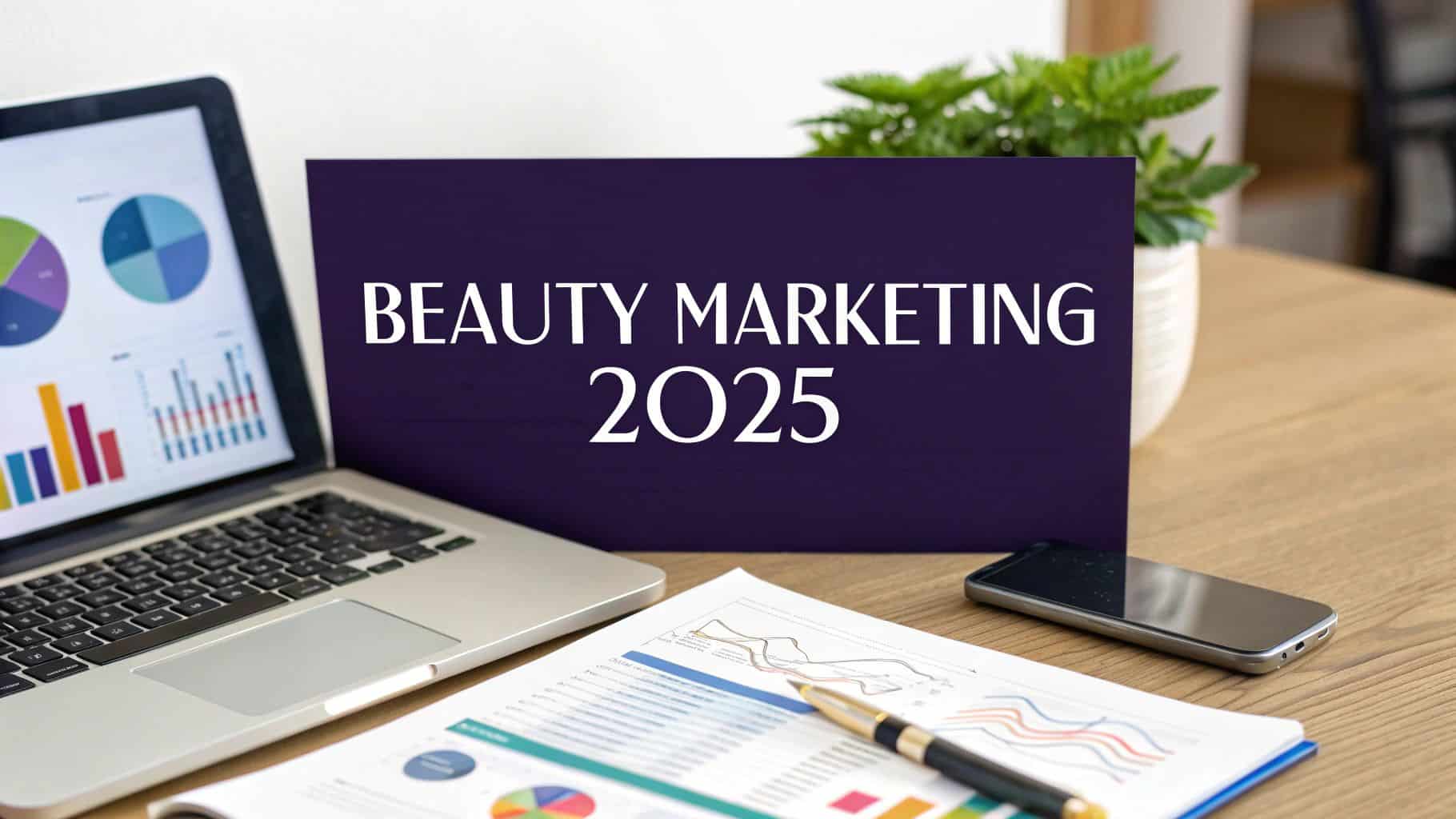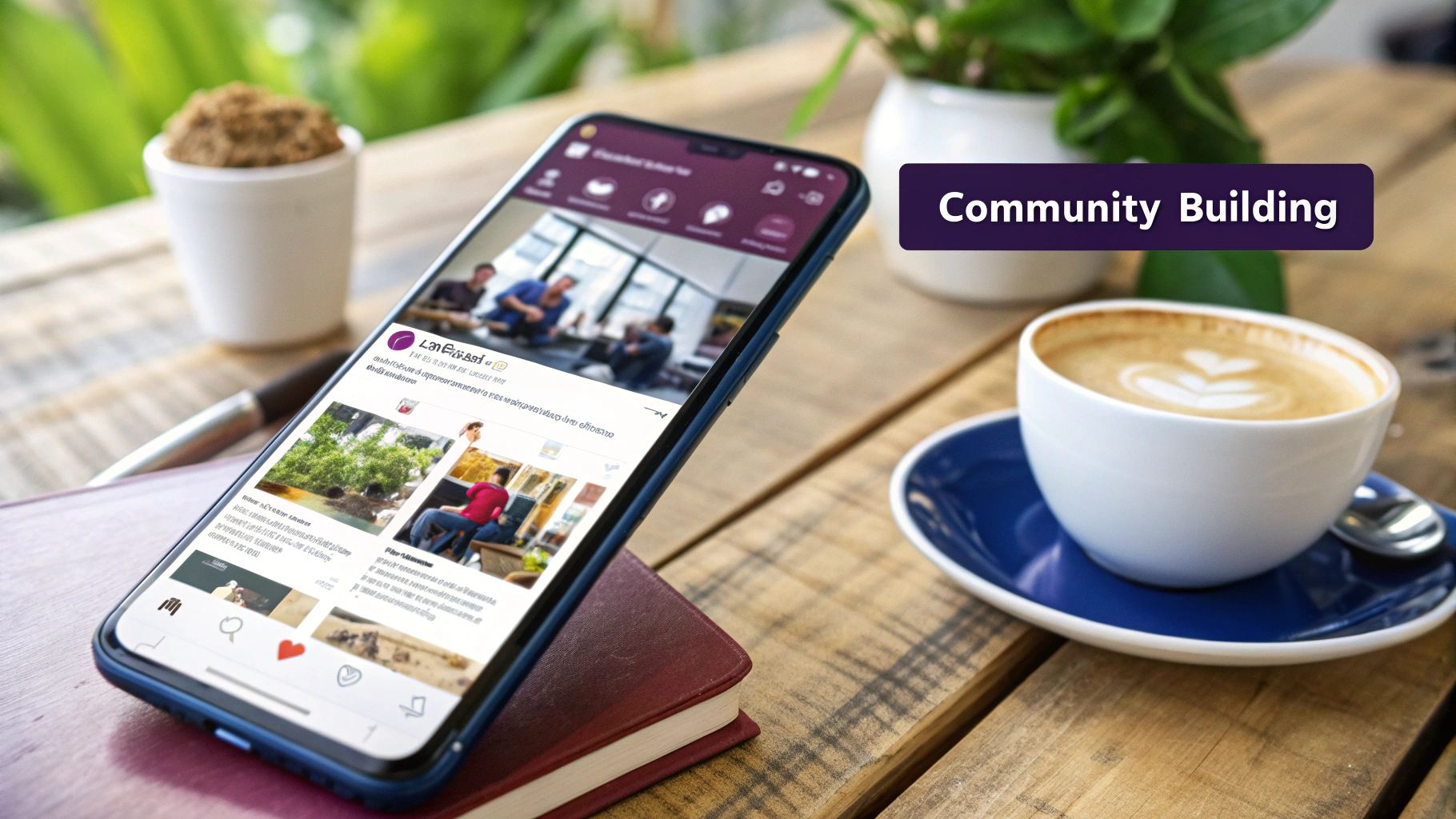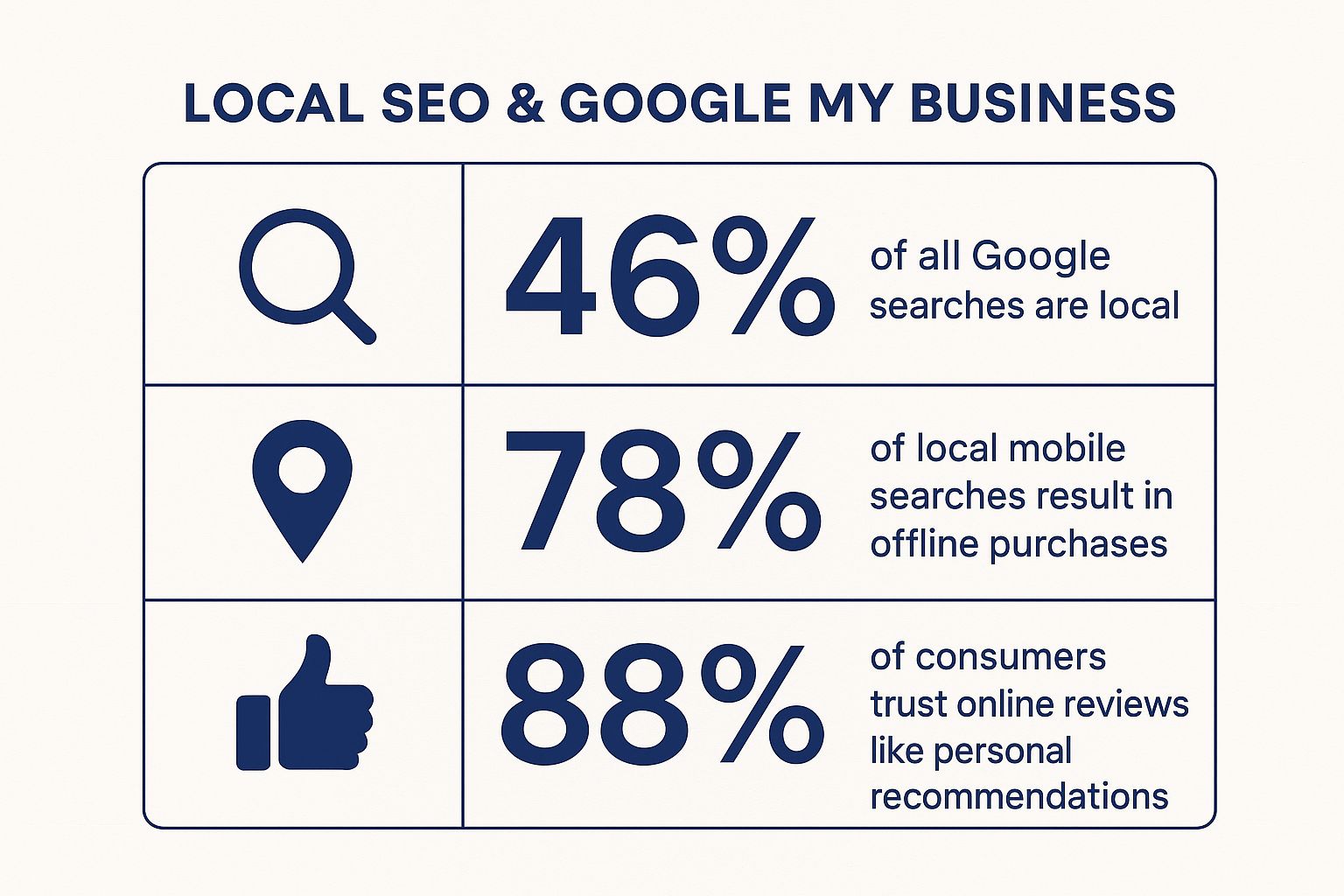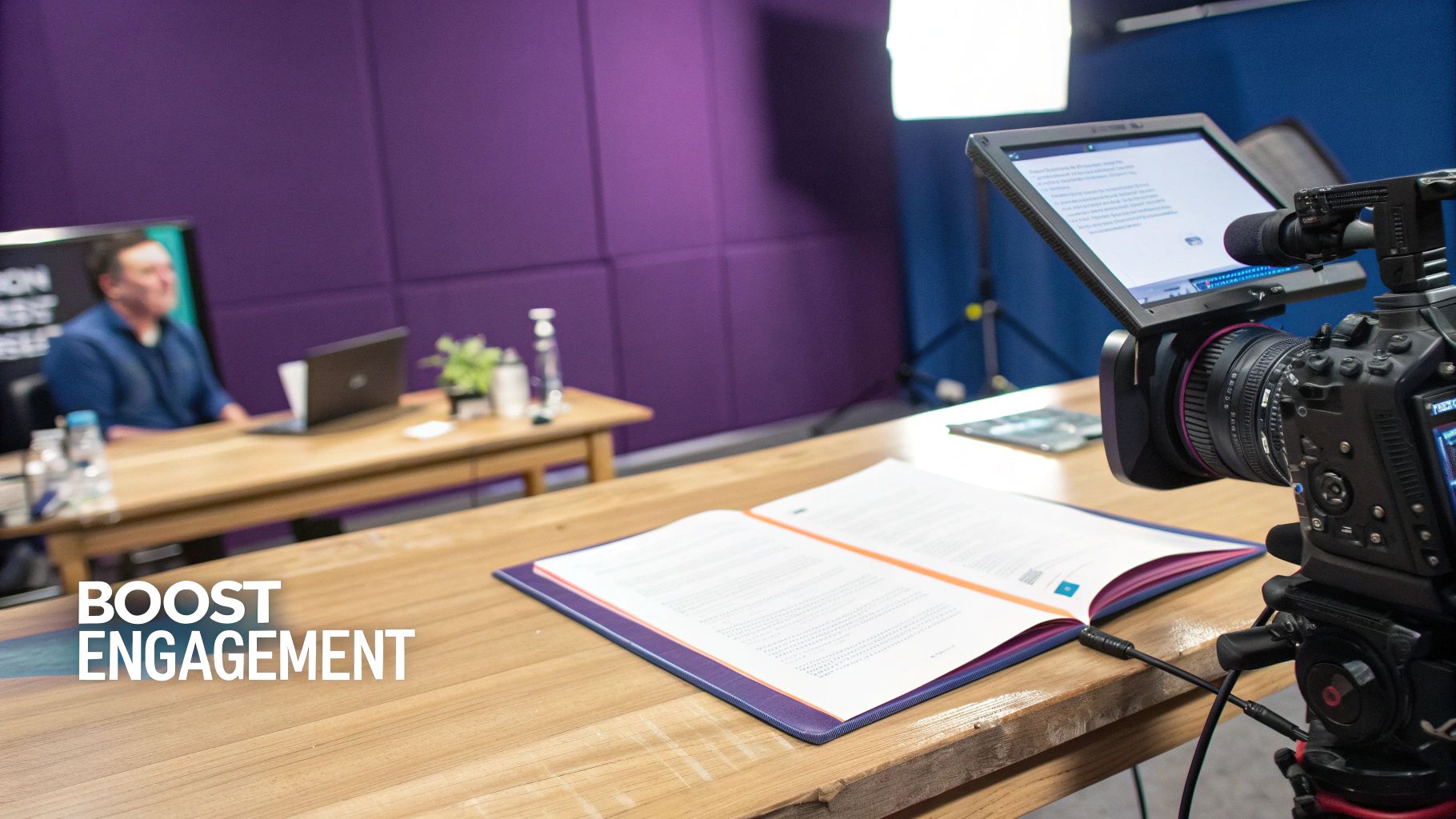Top Online Marketing Strategies for Small Businesses in 2025

In today's competitive market, simply offering a fantastic beauty service or product isn't enough to guarantee success. You need to connect with your audience where they spend their time: online. But navigating the complex world of digital marketing can feel overwhelming for busy salon owners and freelance artists. This guide cuts through the noise. We're breaking down nine powerful and practical online marketing strategies for small businesses, specifically tailored for the beauty industry.
Each strategy is packed with easy-to-follow instructions and actionable insights you can start implementing today. Whether you're a hairstylist, esthetician, or tattoo artist, these proven methods will help you attract new clients, build a loyal community, and grow your business sustainably. We'll explore everything from mastering local search to leveraging the visual power of social media and creating content that captivates. To stay ahead, it's also crucial to understand what Artificial Intelligence in marketing entails and how emerging tools can be integrated into your campaigns for even greater efficiency.
This list is your roadmap to building a comprehensive plan that drives real, measurable results for your beauty brand. Let's get started.
1. Content Marketing: Become the Go-To Beauty Authority
Content marketing is one of the most powerful online marketing strategies for small businesses because it shifts the focus from direct selling to building trust. Instead of just advertising your services, you create and share valuable content that educates, inspires, and solves problems for your target audience. For a beauty business, this means providing expert advice that establishes you as a credible authority in your niche.

When clients see you as a knowledgeable resource, they are more likely to book appointments and purchase products from you. This strategy builds a loyal community that values your expertise, turning followers into paying customers over time.
How to Implement a Beauty Content Strategy
- Action Step 1: Identify Your Clients' Top 3 Questions. Think about what your clients ask you most often. Do they ask how to make lash extensions last longer? Or how to style curtain bangs at home? Write down these questions.
- Action Step 2: Create Content That Answers Those Questions. Turn each question into a piece of content. This could be a short blog post for your website, a quick video tutorial for Instagram Reels, or a helpful graphic. For example, create a post titled "5 Pro Tips to Make Your Lash Extensions Last."
- Action Step 3: Schedule One Post Per Week. Use a simple calendar to plan when you will share your content. Consistency is more important than quantity. Posting just once a week shows potential clients and search engines that you are an active expert.
To deepen your understanding and see how these principles apply in practice, consider exploring various content marketing strategy examples for more inspiration. This approach helps attract new clients organically by proving your value before they even step through your door.
2. Social Media Marketing: Build a Vibrant Online Community
Social media marketing is a vital online marketing strategy for small businesses, transforming platforms like Instagram, TikTok, and Facebook into powerful tools for connection and brand building. It involves more than just posting; it's about creating a two-way conversation with your audience, showcasing your brand’s personality, and turning followers into loyal clients. For a beauty business, this means building an engaged community that trusts your work and feels connected to your salon.

When clients see your stunning results and feel the vibrant culture of your business online, they are far more likely to book a service. This strategy builds brand loyalty and generates powerful social proof, as happy clients tag and share your work, organically expanding your reach.
How to Implement a Beauty Social Media Strategy
- Action Step 1: Pick One Primary Platform. Don't try to be everywhere. If you're a visual business like a salon, start with Instagram or TikTok. Focus on mastering one platform before adding another.
- Action Step 2: Post High-Quality Before-and-Afters. This is the most powerful content for any beauty business. Take clear, well-lit photos and videos of your work. Post at least 3-4 transformations per week to showcase your skills.
- Action Step 3: Engage for 15 Minutes a Day. Set a timer and spend 15 minutes every day responding to comments and direct messages. Ask questions in your captions to encourage conversation (e.g., "What's your biggest hair challenge?"). This simple habit builds a loyal community.
For a deeper dive, learn more about social media marketing for beauty salons to refine your approach. To further explore building a robust online community, consider this ultimate guide to social media growth strategies for small businesses specifically tailored to drive results.
3. Search Engine Optimization (SEO): Attract Clients Searching for You
Search Engine Optimization (SEO) is a fundamental online marketing strategy for small businesses that focuses on making your website more visible on search engines like Google. When a potential client searches for "lash extensions near me" or "best balayage salon in [Your City]," SEO helps your business appear at the top of the results. This drives highly qualified, local traffic directly to your site from people actively looking for the services you offer.
Unlike paid ads, organic traffic from SEO is free and builds long-term digital authority. By optimizing your online presence, you create a sustainable pipeline of new clients who find you precisely when they need you. This strategy establishes your business as a relevant and trusted local option, leading to more bookings and inquiries without a continuous advertising spend.
How to Implement SEO for Your Beauty Business
- Action Step 1: Find Your Local Keywords. Open a browser and type what you think a client would search for. For example, "short curly haircut specialist in Brooklyn." Note the exact phrases that appear. These are your keywords.
- Action Step 2: Update Your Google Business Profile. This is the most important step for local businesses. Log into your Google Business Profile and ensure your name, address, phone number, and hours are 100% correct. Upload at least 10 high-quality photos of your work and salon.
- Action Step 3: Create a Web Page for Each Core Service. Make sure your website has a separate page for each main service (e.g., a page for "Microblading," a page for "Chemical Peels"). Use the keywords you found in Step 1 in the page title and description. This helps Google understand exactly what you offer.
4. Email Marketing: Nurture Relationships Directly in the Inbox
Email marketing is one of the most reliable online marketing strategies for small businesses because it gives you a direct line of communication with your most engaged audience. Unlike social media, where algorithms control who sees your content, an email lands directly in your client's inbox. For a beauty business, this is your chance to nurture relationships, promote exclusive offers, and stay top-of-mind between appointments.
This strategy is powerful because it focuses on a warm audience of people who have already shown interest in your services by subscribing. A well-crafted email can feel like a personal note from a trusted professional, encouraging clients to book their next treatment, try a new service, or purchase a recommended retail product. It transforms a simple contact list into a powerful revenue-generating asset.
How to Implement a Beauty Email Marketing Strategy
- Action Step 1: Choose an Email Platform and Collect Emails. Sign up for a user-friendly service like Mailchimp or Flodesk. At checkout, simply ask every client, "Would you like to join our email list for exclusive offers and tips?"
- Action Step 2: Set Up a Simple Welcome Email. Create one automated email that goes out to new subscribers. It should thank them for joining, briefly introduce your salon, and maybe offer a small discount on their next visit.
- Action Step 3: Send One Valuable Email Per Month. You don't need to send emails constantly. Once a month, send a newsletter with a special offer, a new service announcement, or a helpful tip (like "Your Solution to Winter Dry Skin Is Here"). The goal is to stay connected, not to overwhelm.
5. Pay-Per-Click (PPC) Advertising: Capture Immediate Client Interest
Pay-Per-Click (PPC) advertising is one of the most direct online marketing strategies for small businesses looking for immediate results. Instead of waiting for organic growth, you pay a fee each time someone clicks on your ad. This model allows beauty businesses to appear at the top of search results or in social media feeds, capturing the attention of clients who are actively looking for services.
For a salon or spa, PPC is perfect for promoting special offers, filling last-minute appointment slots, or targeting new clients in your local area. It provides instant visibility and measurable results, making it an excellent way to drive targeted traffic directly to your booking page and test which services or messages resonate most with your audience.
How to Implement a Beauty PPC Strategy
- Action Step 1: Target High-Intent Search Phrases. On platforms like Google Ads, bid on phrases that show someone is ready to buy, like "balayage expert near me" or "book bridal makeup artist [Your City]." Avoid general terms like "hair salon."
- Action Step 2: Write a Compelling, Local Ad. Your ad text must be direct and create urgency. Use this formula: "[Your Service] in [Your Neighborhood]. [Special Offer]. Book Online Now!" Example: "Flawless Lash Extensions in Downtown. 20% Off First Full Set. Book Now!"
- Action Step 3: Use Negative Keywords to Avoid Wasted Clicks. Add negative keywords for terms you don't want to show up for. If you're a lash artist, add "-training," "-school," and "-supplies" to ensure you only pay for clicks from potential clients, not students or other professionals.
To learn the fundamentals and get started, platforms like Google Ads offer extensive guides and tools to help you launch your first campaign. By carefully managing your budget and targeting, PPC can deliver a strong return on investment by connecting you with new clients instantly.
6. Local SEO and Google My Business: Dominate Your Neighborhood
Local SEO is a specialized online marketing strategy designed to make your beauty business more visible in local search results. When a potential client in your area searches "nail salon near me" or "best hairdresser in [Your City]," Local SEO ensures your business appears prominently on Google Maps and in the local search listings. It's about capturing high-intent customers who are actively looking for your services right now.
This approach is critical for service-based businesses like salons and spas that rely on foot traffic. By optimizing your digital footprint for your specific geographic area, you connect directly with clients in your community, driving both online discovery and in-person appointments.
Below is an infographic highlighting just how crucial local search is for small businesses.

These statistics reveal a clear path from a local search to a sale, underscoring that a strong local presence directly translates into revenue and that reviews are the modern-day word-of-mouth.
How to Implement a Local SEO Strategy
- Action Step 1: Claim and Fully Optimize Your Google Business Profile. This is your #1 local marketing tool. Go to google.com/business and claim your listing. Fill out every single section: services, photos, business hours, and description. This is the most important 30 minutes you can spend on local marketing.
- Action Step 2: Ask Every Happy Client for a Review. At the end of a great service, say, "I'm so glad you love your results! It would mean the world to me if you could leave a quick review on Google. It really helps my small business." Then, text them the direct link.
- Action Step 3: Check Your NAP Consistency. Your Name, Address, and Phone number (NAP) must be written the exact same way everywhere online (your website, Google, Yelp, Instagram bio). For example, if you use "St." on one platform and "Street" on another, it can confuse Google. Pick one format and stick to it.
By focusing on these steps, you can turn local searches into loyal clients. To master this essential element of your marketing, explore how Google reviews impact your beauty business's Local SEO and learn how to leverage them effectively.
7. Influencer Marketing: Leverage Trusted Voices to Build Credibility
Influencer marketing is a powerful strategy that involves partnering with individuals who have a dedicated social following and are seen as experts in the beauty niche. Instead of you telling potential clients how great your services are, a trusted voice they already follow does it for them. This creates authentic social proof and builds immediate trust with a relevant audience.
For a small beauty business, collaborating with local or micro-influencers offers a highly effective way to reach new clients. These creators often have smaller but more engaged communities that value their recommendations, making their endorsements feel like genuine advice from a friend rather than a paid advertisement. This approach is one of the most direct online marketing strategies for small businesses looking to tap into pre-built, loyal audiences.
How to Implement an Influencer Marketing Strategy
- Action Step 1: Find Local Micro-Influencers. On Instagram, search for hashtags like #[YourCity]Blogger or #[YourCity]Beauty. Look for accounts with 1,000-10,000 followers who post content that matches your brand's style. Check that their followers are leaving real, engaged comments.
- Action Step 2: Offer a Clear Service Exchange. Send a direct message proposing a simple trade. For example: "Hi [Name], I love your content! I'm a lash artist in [Your City] and would love to offer you a complimentary full set in exchange for one Instagram post and three stories."
- Action Step 3: Provide a Unique Discount Code to Track Results. Give the influencer a special code for their followers, like "SARAH15" for 15% off. This is the easiest way to see exactly how many new clients their collaboration brought to your business.
To find and manage potential collaborators effectively, platforms like AspireIQ can help streamline the process from discovery to campaign measurement, making it easier to build lasting and profitable partnerships.
8. Video Marketing: Bring Your Beauty Services to Life
Video marketing has become one of the most compelling online marketing strategies for small businesses, allowing you to showcase your services in a dynamic and engaging way. For a beauty business, video lets you demonstrate your skill, personality, and the transformative results you deliver, which static images simply cannot capture. It’s an effective way to build a personal connection and show potential clients exactly what they can expect.

From short-form clips on TikTok and Reels to in-depth YouTube tutorials, video content helps you stand out in a crowded market. By showing your work in action, you build trust and excitement, making viewers more likely to book an appointment and experience your services firsthand.
How to Implement a Beauty Video Strategy
- Action Step 1: Create Satisfying "Before and After" Reels. This is your easiest win. Use your phone to film a quick "before" shot, a few seconds of your process, and a final "reveal." Edit it into a 10-15 second video on Instagram Reels or TikTok with trending audio.
- Action Step 2: Answer One Client Question on Video. Think of a common question you get. Set up your phone and record a 30-second video of you answering it. For example, a nail tech can show "The right way to remove gel polish at home to avoid damage." This positions you as an expert.
- Action Step 3: Go Live for a Q&A Session. Once a month, go Live on Instagram for 15 minutes. Announce it beforehand and tell your followers to bring their beauty questions. This direct, real-time interaction builds an incredibly strong and loyal community.
For a deeper dive into creating professional-looking videos with minimal equipment, exploring a guide to video marketing for small businesses can provide essential tips on lighting, sound, and editing. This approach turns passive viewers into engaged potential clients by visually proving your expertise and the quality of your work.
9. Conversion Rate Optimization (CRO): Turn Clicks Into Clients
Conversion Rate Optimization (CRO) is the systematic process of improving your website to increase the percentage of visitors who take a desired action. Instead of just focusing on getting more traffic, CRO helps you get more value from the visitors you already have. For a beauty business, this means turning website browsers into booked appointments or product purchasers.
By analyzing how users interact with your site and testing small changes, you can remove friction from the booking process and make it easier for potential clients to say "yes." This data-driven approach is one of the most effective online marketing strategies for small businesses because it directly impacts your bottom line without needing a bigger marketing budget.
How to Implement CRO for Your Beauty Business
- Action Step 1: Make Your "Book Now" Button Obvious. Your main call-to-action button should be impossible to miss. Use a bright, contrasting color and place it at the top of your homepage. Test simple, direct text like "Book Now" or "Book Your Appointment."
- Action Step 2: Simplify Your Booking Process. Go through your own online booking process. Does it ask for too much information? Is it confusing on a mobile phone? Remove any unnecessary steps or form fields to make it as fast and easy as possible.
- Action Step 3: Add Trust Signals Near Your Booking Button. Place a powerful client testimonial or a great before-and-after photo directly next to your "Book Now" button. This small addition can provide the final push of confidence a potential client needs to schedule.
By focusing on these incremental improvements, you can significantly boost your booking rates. To make sure your optimizations align with client expectations, it's wise to stay informed about the latest beauty industry trends for 2024 and what modern consumers are looking for.
Online Marketing Strategies Comparison Table
| Marketing Strategy | 🔄 Implementation Complexity | ⚡ Resource Requirements | 📊 Expected Outcomes | 💡 Ideal Use Cases | ⭐ Key Advantages |
|---|---|---|---|---|---|
| Content Marketing | Medium – requires ongoing content creation and strategy expertise | Low to Medium – mostly time and content production | Medium-term – 3-6 months for results; long-term organic traffic growth | Building brand authority, SEO improvement, lead nurturing | Builds trust; cost-effective; establishes thought leadership |
| Social Media Marketing | High – daily management and adaptation to platform algorithms | Medium – content creation, community management, ads | Variable – real-time engagement and brand awareness | Direct audience engagement, viral content, brand personality | Direct communication; viral potential; detailed targeting |
| Search Engine Optimization (SEO) | Medium to High – requires technical knowledge and ongoing efforts | Medium – keyword research, site optimization tools | Medium to Long-term – 3-6 months for significant ranking improvements | Increasing organic traffic, targeting high-intent searchers | Sustainable traffic; high credibility; passive lead gen |
| Email Marketing | Medium – needs permission-based setup and content automation | Low to Medium – email platforms and list management | Fast to Medium – measurable ROI, ongoing nurturing | Customer retention, direct promotions, personalized communication | Highest ROI; direct and measurable; automated nurturing |
| Pay-Per-Click (PPC) Advertising | High – requires ongoing management, optimization, budget control | Medium to High – ad spend and campaign management | Immediate – fast traffic and instant visibility | Testing market demand, short-term promotions, generating quick leads | Immediate results; precise targeting; full budget control |
| Local SEO and Google My Business | Medium – focused on local optimization and review management | Low to Medium – managing listings, citations, and review responses | Medium-term – improves local search visibility and foot traffic | Businesses with physical locations aiming for local customers | High conversion local targeting; less competition; builds trust |
| Influencer Marketing | Medium to High – depends on influencer vetting and campaign management | Medium to High – payments to influencers, tracking | Variable – brand awareness and engagement; ROI measurement challenges | Brand awareness, authentic reach, niche market promotion | Access to engaged audiences; authentic content; high engagement |
| Video Marketing | High – requires production skills, equipment, and editing | Medium to High – production cost and time | Medium to Long-term – strong engagement and conversion lift | Explaining complex products, boosting engagement, storytelling | Higher engagement; better SEO; emotional connection |
| Conversion Rate Optimization (CRO) | High – needs technical skills, data analysis, ongoing testing | Medium – analytics tools and testing platforms | Medium-term – continuous improvement in conversion rates | Maximizing value of existing traffic, improving UX, increasing revenue | Maximizes ROI; data-driven; reduces acquisition costs |
Putting Your Marketing Plan into Action
Navigating the world of digital promotion can feel like an overwhelming task, especially when you're busy perfecting your craft as a salon owner, lash artist, or esthetician. The comprehensive list of online marketing strategies for small businesses we've explored, from the foundational power of SEO to the personal touch of email marketing and the visual appeal of video, represents a full toolkit for growth. Each strategy offers a unique pathway to connect with new clients and build lasting loyalty with existing ones.
The crucial takeaway isn't to master all nine strategies overnight. Instead, the goal is to build sustainable momentum. True success comes from strategic implementation, not from spreading yourself too thin. Trying to launch a PPC campaign, a video series, and an influencer collaboration all in the same month is a recipe for burnout. The real power lies in consistency and focus.
Your Actionable Next Steps
To transform these ideas into tangible results, start by taking a breath and choosing a single starting point. Don't let the sheer number of options lead to inaction. Instead, follow this simple, focused approach:
- Select Your Starting Strategy: Review the strategies discussed. Which one resonates most with you? If you love creating visual content, perhaps Video Marketing on Instagram Reels or TikTok is your ideal entry point. If you want to capture immediate local demand, dedicating a week to perfecting your Google Business Profile is a high-impact choice. Pick one that feels manageable and aligns with your business goals.
- Commit to a 30-Day Plan: Once you've chosen your strategy, create a simple plan for the next 30 days. For Content Marketing, this could mean writing and publishing one blog post per week. For Email Marketing, it could involve creating a simple welcome email and sending out one promotional newsletter. The key is to set a realistic, repeatable goal.
- Measure and Adapt: At the end of the 30 days, review your efforts. Did your Google Business Profile views increase? Did your blog post bring in any new traffic? Use these insights to decide your next move. You can either double down on what’s working or layer in a second, complementary strategy.
The most effective online marketing strategies for small businesses are not the most complex; they are the ones you can execute consistently. By focusing on one or two key areas, you build a strong foundation, creating a powerful digital presence that works for you, attracting the right clients and allowing your unique talent to shine. This focused effort is what separates struggling businesses from thriving ones.
Ready to build a professional online presence that integrates these strategies seamlessly? A powerful, beautiful website is your foundation. Discover how gohappybeauty provides an all-in-one platform with built-in SEO, booking, and marketing tools designed specifically for beauty professionals like you. Start building your dream website today.
Grow your beauty business
Our focus is, and always will be, helping you improve your online presence and generate more business from your website. That is what we do, for you.

